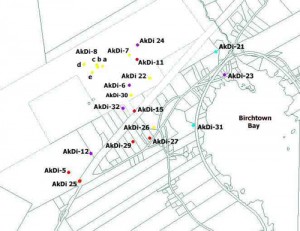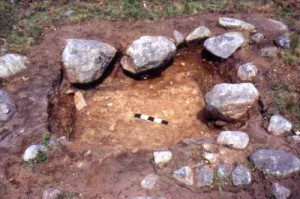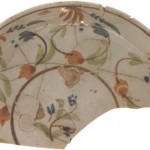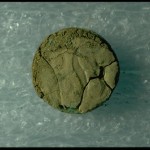 Archaeological surveys at Birchtown have been on-going since 1992. Some of the discoveries during this research have included uncovering early Black Loyalist dwellings and property partitions, finding 18th century military buttons, a scythe and dishware. In all, more than 16,000 artifacts, leading back to early Black Loyalist occupation in Nova Scotia, have been unearthed and several of the artifacts are on display at the Old School House Museum.
Archaeological surveys at Birchtown have been on-going since 1992. Some of the discoveries during this research have included uncovering early Black Loyalist dwellings and property partitions, finding 18th century military buttons, a scythe and dishware. In all, more than 16,000 artifacts, leading back to early Black Loyalist occupation in Nova Scotia, have been unearthed and several of the artifacts are on display at the Old School House Museum.
1993- Lead by Laird Niven and Stephen Powell – hired to conduct archaeological surveys in Birchtown because Fox Ridges, an area known to be the location of original Black Loyalist Land grants, was being threatened with a proposed land fill. Survey identified 20 structures that ranged in type from shallow depressions to deep stone cellars and in date from the 18th century to the 20th century.
1994 – Lead by Dr. Stephen Davis, St. Mary’s University – an archaeological field school was conducted on the late 18th century site – AkDi 12 – which was found during the 1993 survey.  The site was believed to be within the original land grant of Birchtown and that of an original Black Loyalist. The excavation was a success – evidence suggested the site was more complex than expected, apparently destroyed and intentionally burned at some time in the 1790’s. The most important feature excavated in 1994 was the cellar hole. It was first assumed to be a root cellar, however, upon further investigation and excavation, it was interpreted as the remains of a temporary structure build to survive at least the first winter of 1783 – what we call today the Black Loyalist Pit House.
The site was believed to be within the original land grant of Birchtown and that of an original Black Loyalist. The excavation was a success – evidence suggested the site was more complex than expected, apparently destroyed and intentionally burned at some time in the 1790’s. The most important feature excavated in 1994 was the cellar hole. It was first assumed to be a root cellar, however, upon further investigation and excavation, it was interpreted as the remains of a temporary structure build to survive at least the first winter of 1783 – what we call today the Black Loyalist Pit House.
1995 – Lead by Laird Niven – testing on sites AkDi 16 to 21. AkDi 16 was noted in the 1994 survey, but was not recorded. After tests were complete, results were inconclusive. Further recording resulted in identifying 5 previously unknown sites – AkDi 17 to 21. The most significant of these was an unusual group of rock features located near the heart of Birchtown – later to become known as the Mysterious Mounds.
1996 – Lead by Laird Niven, who was working for the Nova Scotia Museum. This survey was done to continue investigating the unusual group of rocks uncovered in 1995. The function and purpose of these groups of rocks remain an enigma at present.
1997 – Lead by Laird Niven through the Nova Scotia Museum. This survey was done to record features that were previously identified in earlier survey. The survey was done using a laser theodolite. It was discovered that the main threat for these features was actively associated with logging.
1998 – Lead by Laird Niven through the Nova Scotia Museum – Excavate site AkDi 23 to search for the location of Stephen Blucke’s house. Over 12,000 artifacts were recovered from this site, the majority being ceramics.
 There was also an unusual number of military items recovered, including Revolutionary War buttons, a triangular bayonet, a sling swivel, a British navel boarding axe and an iron spur. The sheer number of artifacts, the quality of the pieces and the number of matched sets allowed the archaeologist to assume this was indeed the location of Stephen Blucke’s property.
There was also an unusual number of military items recovered, including Revolutionary War buttons, a triangular bayonet, a sling swivel, a British navel boarding axe and an iron spur. The sheer number of artifacts, the quality of the pieces and the number of matched sets allowed the archaeologist to assume this was indeed the location of Stephen Blucke’s property.
1999 – Laird Niven continued surveying the rock features identified in 1995 and later re-examined in 1996. He found a series of 20 rock features.
2001- 2002 – Laird Niven with Heather MacLead Leslie of In Situ, continued recording the rock walls and mounds using technologies in Global Positioning System (GPS), Geographic Information System (GIS) and remote sensing which are tools used in heritage research, locating archaeological sites, roads, rivers, property boundaries, etc. This technology is very useful in research and can be used in heritage site protection, preservation and tourism
2004 -2005 – the BLHS undertook the Black Loyalist Identity Archaeology Project, led by Heather MacLeod Leslie. Three areas were included in the project, Delap’s Cove, Rear Monastery and Birchtown, Shelburne County. Excavations were carried out in the first two areas and data collected in previous excavations was used for the latter. The data created by this project was used to become part of a body of newly developing knowledge on the historical archaeology and cultural heritage of African Nova Scotians.
2008 – Birchtown was the location of a student Archaeological Field School instructed by Heather MacLeod Leslie. Four students from St. Mary’s University participated in this field school. The first goal for the field research project at Birchtown was to open large areas between the rock mounds at AkDi-31; to collect soil samples; and collect any artefactual evidence present to assist in the determination of the function of the mound complexes at Birchtown. Reports for the findings of this field school have not been released yet.
